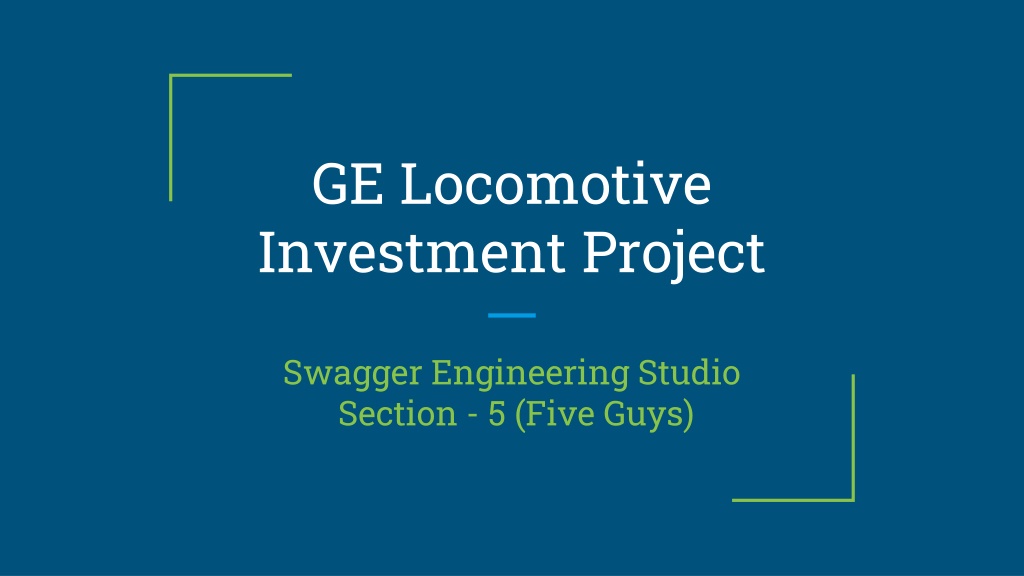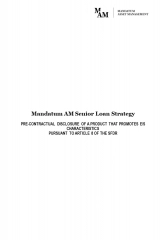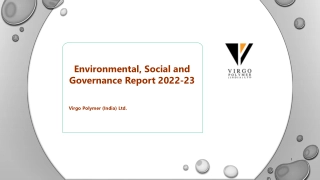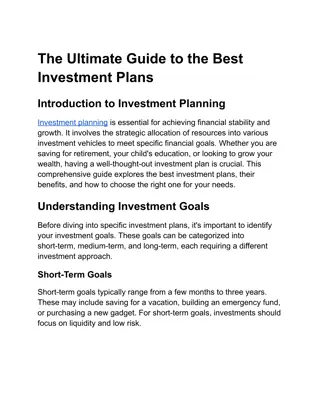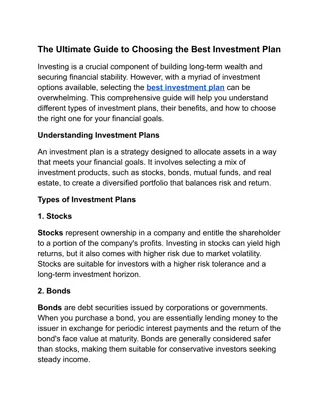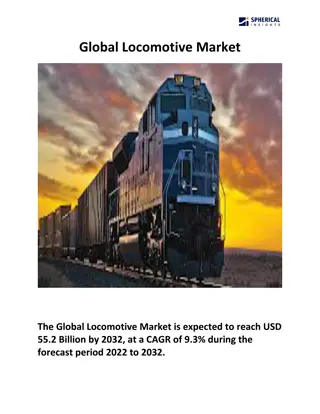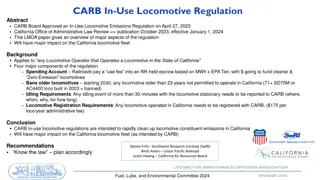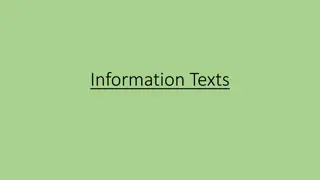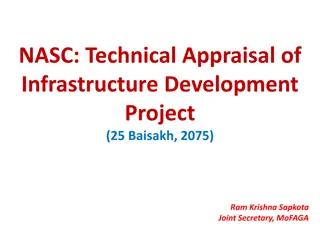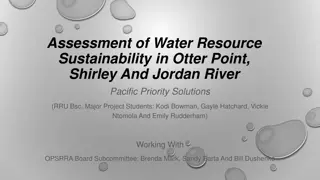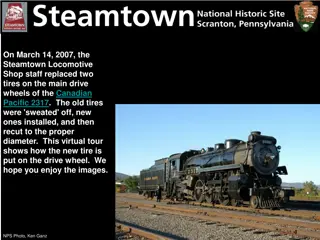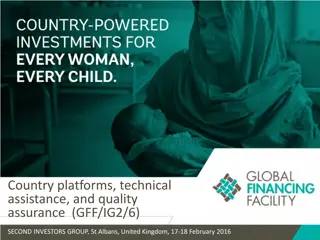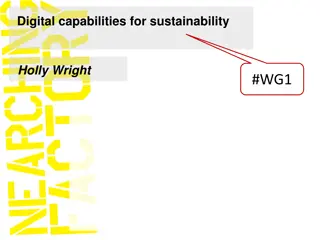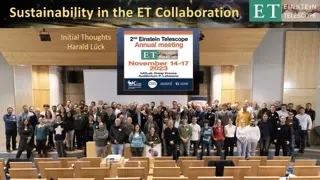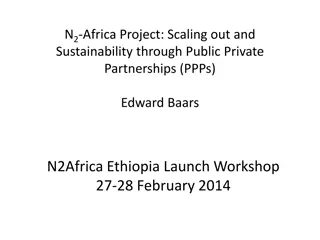GE Locomotive Investment Project: Enhancing Sustainability in Pittsdelphia
The report outlines a comprehensive solution to address smog and NOx emissions in Pittsdelphia by upgrading locomotives to Tier 4 standards and using LNG as fuel. Team dynamics improved, leading to increased productivity. Customer needs and target specifications were analyzed, followed by concept generation through brainstorming and concept selection. The project aims to meet emissions standards, maintain freight capacities, and reduce environmental impact.
Download Presentation

Please find below an Image/Link to download the presentation.
The content on the website is provided AS IS for your information and personal use only. It may not be sold, licensed, or shared on other websites without obtaining consent from the author. Download presentation by click this link. If you encounter any issues during the download, it is possible that the publisher has removed the file from their server.
E N D
Presentation Transcript
GE Locomotive Investment Project Swagger Engineering Studio Section - 5 (Five Guys)
Introduction The report presents a well-thought solution for the problem of smog and NOx emissions in Pittsdelphia. The solution comprises of upgrading the locomotives to the latest Tier 4 locomotives which reduces the NOx emissions and smog. This also makes sure that the freight capacities are not affected. To tackle the problems of costs and fuel, the report also expands on using LNG as a fuel source to power the locomotives. It also discusses the standards of benchmarking, metrics, costs and benefits and the characteristic traits of the team members.
Team Dynamics The team members underwent a few behavioural changes during the semester but the team remained cohesive and structured. The team members developed an openness in their behaviour leading to a large inflow of innovative ideas. The members also a little less stressed which increased the team s productivity levels. The net conscientiousness and agreeableness of the team remained largely unchanged.
Customer Needs (City) List of needs was compiled from GE presentation. Included: Meeting Tier 3 Emissions Standards Maintaining 165,000 tons of freight per day Lowering NOx emissions to reduce smog
Target Specifications Using the GE presentation we were able to set marginally acceptable specifications for our concepts such as: Tons of freight shipped per day Tons of minerals shipped per day Particulate matter produced in g/hp-hr NOx produced in g/hp-hr From these marginally acceptable specifications we could set our ideal specifications that would be considered in concept generation.
Concept Generation Our Primary concept generation was brainstorming During this process,we prioritized points Fuelefficiency Environment Public opinion Etc Other method Off the books C-Sketching Passed a piece of paper around starting with base conceptand grew on thatidea
Concept Selection Narrowing down with just pros and cons Once narrowed down to three ideas we used a pugh chart Using the results the Pugh Chart got from the weighted topics we found important,we got the best idea to proceed on.
Alternative Methods that Didnt make Pugh Chart Upgrading all trains to LNG fuel source The Nuclear Train Photovoltaic panels placed on the freight cars Charge a battery car or run straight to a secondary engine at cruising speed Replacing one locomotive per train with a hydrogen fuel cell powered locomotive with other locomotives would be upgraded to tier 3 with a NOx aftertreatment
Overall Design and Plan The best option would be a straight upgrade from all tier 2 to all tier 4 Tier 2 locomotives would be sold to buyers with less strict environmental regulations Along with this, 20 locomotives would be converted to run on Liquefied Natural Gas (LNG) LNG has many advantages over other options: Cheap Lightweight = more fuel efficient Highest BTU/Lb
EPA Analysis of the plan is to sell off the old tier II s and replace them with brand new tier IV s. of the fleet meets tier IV requirements is converting existing tier II s to LNG, reducing NOx by 50% & Part.s by 80% of the fleet meets at least tier III requirements. IV requirements requires upgrade to tier III before conversions or conversion of a new tier IV to LNG.
Emissions - before (II) Particulates NOx 5.5g/hp-hr * 4500hp * 10hr/day 247.5kg per locomotive per day x45 Locomotives 11137.5 kg/day .2g/hp-hr * 4500hp * 10hr/day 9kg per locomotive per day x45 Locomotives 405 kg/day
Emissions - After NEW tier IV s (Assumed - comparable hp) Particulates .03 g/hp-hr * 4500hp * 10 hr/day 1.35 kg-loco./day 40.5 kg/day NOx 1.3 g/hp-hr * 4500 * 10 hr/day 58.5 kg-loco/day x30 locomotives 1755 kg/day x30 locomotives LNG tier II converts Particulates 9 kg-loco./day * .2 (80% cleaner) = 1.8 kg-loco./day x20 locomotives 36 kg/day OVERALL NOx -- 2475 + 1755 = 4230 kg/day Particulates -- 36 + 40.5 = 76.5 kg/day NOx 247 kg-loco/day * .5 (50% cleaner) = 123.75 kg-loco./day
Fuel Costs - Before 250 miles 1 way Coal - 12K out, 1K in Freight - 7K out, 3K in Mileage (II) = 470 miles per ton per gallon Coal Trains Freight Trains (7000 gal/470 miles) * 250 miles = 3725 gallons (12,000 gal/470 miles) * 250 miles = 6383 gallons (3000 gal/470 miles) * 250 miles = 1595 gallons (1000 gal/470 miles) * 250 miles = 532 gallons 5320 gallons round-trip * $2.50 = $13,300 per TRAIN 6915 gallons round-trip * $2.50 = $17,287 per TRAIN x15 trains/day $199,500 per day x5 trains/day $86,437 per day TOTAL 199,500+ 86,438 =
Investment Costs 1 Billion -Fuel Stations procurement (initial timeframe) 20 Million -20 tier II conversions 120 Million -30 NEW tier IV s (over time) sell old tier II s for .5 -1.5 million per, depending on when, making each IV cost 2.5 - 3.5 million additional 100M for new converts and new tier IV s once the lifespan of the current tier II converts is expired.
Fuel Costs - After 250 miles 1 way Coal - 12K out, 1K in Freight - 7K out, 3K in Mileage (II LNG convert) = 564 miles per ton per gallon LNG = $.40 Diesel = $2.50 95% LNG ---5% Diesel (for ignition) = $.50 per gallon Coal Trains Freight Trains (7000 gal/564 miles) * 250 miles = 3103 gallons (12,000 gal/564 miles) * 250 miles = 5319 gallons (3000 gal/564 miles) * 250 miles = 1330 gallons (1000 gal/564 miles) * 250 miles = 445 gallons 4433 gallons round-trip * $.50 = $2,216 per TRAIN 5764 gallons round-trip * $.50 = $2,882 per TRAIN x15 trains/day x5 trains/day ($33,247 per day * locomotives LNG) + $ Diesel (IV) ($14,410 per day * locomotives LNG) + $ Diesel (IV) ----------------------------------------------------------------------------- $116,373 --------------------------------------------------------------------------------------------------------
Freight capacity and On time delivery unchanged
Investment (cont) $1,000,000,000 / ($107,136 * 365.25) = 25.5 years to pay off ALL INFRASTRUCTURE FOR LNG Thats within the lifetimes of the tier II s converted. ------------------------------------------------------------------------------------------------------------- + 20M ( IV converts) + 80M (tier IV s) $240,000,000 / ($107,136 * 365.25) = additional 6 years to make back conversion costs and tier IV investment costs
Scalability Once all tier 4's are purchased, the alternative fuels are scalable More tier 4's can be converted to LNG, increasing alternative energy usage Increasing gasoline costs will drive the LNG conversations With profits coming in, conversation to LNG can be increasingly worth it. And the more are converted, the more profits come in, and the more options it gives you
